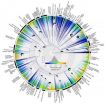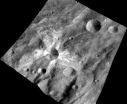(Press-News.org) When people worry about math, the brain feels the pain
Mathematics anxiety can prompt a response in the brain similar to when a person experiences physical pain, according to new research at the University of Chicago.
Using brain scans, scholars determined that the brain areas active when highly math-anxious people prepare to do math overlap with the same brain areas that register the threat of bodily harm—and in some cases, physical pain.
"For someone who has math anxiety, the anticipation of doing math prompts a similar brain reaction as when they experience pain—say, burning one's hand on a hot stove," said Sian Beilock, professor of psychology at the University of Chicago and a leading expert on math anxiety.
Surprisingly, the researchers found it was the anticipation of having to do math, and not actually doing math itself, that looked like pain in the brain.
"The brain activation does not happen during math performance, suggesting that it is not the math itself that hurts; rather the anticipation of math is painful," added Ian Lyons, a 2012 PhD graduate in psychology from UChicago and a postdoctoral scholar at Western University in Ontario, Canada.
The two report their findings in a paper, "When Math Hurts: Math Anxiety Predicts Pain Network Activation in Anticipation of Doing Math," in the current issue of PlOS One.
For the study, the scholars worked with 14 adults who were shown to have math anxiety based on their responses to a series of questions about math.
The questions gauged one's anxiety when receiving a math textbook, walking to math class or realizing math requirements for graduation. Additional tests showed that these individuals were not overly anxious in general; instead, their heightened sense of anxiety was specific to math-related situations.
The study volunteers were tested in an fMRI machine, which allowed researchers to examine brain activity as they did math. Volunteers were given mathematics equations to verify — for example, the validity of the following equation: (12 x 4) – 19 = 29. While in the fMRI scanner, subjects were also shown short word puzzles. For these puzzles, people saw a series of letters (for example: yrestym) and had to determine if reversing the order of the letters produced a correctly spelled English word.
The fMRI scans showed that the anticipation of math caused a response in the brain similar to physical pain. The higher a person's anxiety about math, the more anticipating math activated the posterior insula—a fold of tissue located deep inside the brain just above the ear that is associated with registering direct threats to the body as well as the experience of pain.
Interestingly, math anxiety levels were not associated with brain activity in the insula or in any other neural region when volunteers were doing math.
The work by Lyons and Beilock suggests that, for those with math anxiety, a painful sense of dread may begin long before a person sits down to take a math test. Previous research has shown that highly math anxious individuals tend to avoid math-related situations and even math-related career paths. The current work suggests that such avoidance stems in part from painful anxiety.
The current work is also consistent with other research from Beilock and Lyons, in which they showed that the mere anticipation of doing mathematics changes functioning in the brains of people with high levels of math anxiety. Beilock's work, supported by the National Science Foundation and the Department of Education, has also shown that mathematics anxiety can begin as early as first grade, and that female elementary school teachers often transmit their math anxiety to their female students.
This latest study points to the value of seeing math anxiety not just as a proxy for poor math ability, but as an indication there can be a real, negative psychological reaction to the prospect of doing math. This reaction needs to be addressed like any other phobia, the researchers said. Rather than simply piling on math homework for students who are anxious about math, students need active help to become more comfortable with the subject, Beilock said. Beilock's work has shown, for instance, that writing about math anxieties before a test can reduce one's worries and lead to better performance.
###
Beilock is the author of the best-selling book about stress and performance, "Choke: What The Secrets Of The Brain Reveal About Getting It Right When You Have To".
When people worry about math, the brain feels the pain
2012-11-01
ELSE PRESS RELEASES FROM THIS DATE:
Patients with diabetes left in the dark
2012-11-01
Patients newly diagnosed with type 2 diabetes feel "left in the dark" and unsure what they can and can't eat whilst sometimes waiting months to receive diabetes education, according to a new study published online today in the journal Primary Health Care Research & Development (1). The research carried out by Dr Michelle McKinley and colleagues at Queen's University Belfast, explored the views of people recently diagnosed with diabetes and discovered that whilst waiting for a referral to a diabetes education programme, they received little or no information about what to ...
Alcohol increases activity of the resting brain in social drinkers
2012-11-01
Short-term alcohol intake can increase the activity of functional connections across the human brain when it is at rest, according to research published Oct 31 in the open access journal PLOS ONE by Panagiotis Bamidis and colleagues from the Aristotle University of Thessaloniki, Greece.
Previous studies have shown that alcohol intake increases transmission of signals by the neurotransmitter GABA, present in 40% of the connections between nerve cells in the brain. Here, the researchers monitored resting brain activity in healthy social drinkers who had consumed one drink, ...
Exhaustive family tree for birds shows recent, rapid diversification
2012-11-01
New Haven, Conn. — A Yale-led scientific team has produced the most comprehensive family tree for birds to date, connecting all living bird species — nearly 10,000 in total — and revealing surprising new details about their evolutionary history and its geographic context.
Analysis of the family tree shows when and where birds diversified — and that birds' diversification rate has increased over the last 50 million years, challenging the conventional wisdom of biodiversity experts.
"It's the first time that we have — for such a large group of species and with such a ...
First ever family tree for all living birds reveals evolution and diversification
2012-11-01
The world's first family tree linking all living bids and revealing when and where they evolved and diversified since dinosaurs walked the earth has been created by scientists from the University of Sheffield.
Experts used the family tree to map out where the almost 10,000 species of birds live to show where the most diversification has taken place in the world.
Researchers, from the University of Sheffield, Yale University, University of Tasmania and Simon Fraser University, say the creation of new species has speeded-up over the last 50 million years. Surprisingly, ...
High blood pressure damages the brain in early middle age
2012-11-01
Uncontrolled high blood pressure damages the brain's structure and function as early as young middle-age, and even the brains of middle-aged people who clinically would not be considered to have hypertension have evidence of silent structural brain damage, a study led by researchers at UC Davis has found.
The investigation found accelerated brain aging among hypertensive and prehypertensive individuals in their 40s, including damage to the structural integrity of the brain's white matter and the volume of its gray matter, suggesting that vascular brain injury "develops ...
Protoplanet Vesta: Forever young?
2012-11-01
Like a movie star constantly retouching her makeup, the protoplanet Vesta is continually stirring its outermost layer and presenting a young face.
New data from NASA's Dawn mission show that a common form of weathering that affects many airless bodies like Vesta in the inner solar system, including the moon, surprisingly doesn't age the protoplanet's outermost layer.
The data also indicate that carbon-rich asteroids have been splattering dark material on Vesta's surface over a long span of the body's history.
The findings are described in two papers published ...
Assembly not required
2012-11-01
Cambridge, Mass. - October 31, 2012 - Scientists have created new kinds of particles, 1/100th the diameter of a human hair, that spontaneously assemble themselves into structures resembling molecules made from atoms. These new particles come together, or "self-assemble," to form structures in patterns that were previously impossible to make and hold promise for manufacturing advanced optical materials and ceramics.
The method, described in the latest issue of the journal Nature, was developed by a team of chemists, chemical engineers, and physicists at New York University ...
Virtual reality 'beaming' technology transforms human-animal interaction
2012-11-01
Using cutting-edge virtual reality technology, researchers have 'beamed' a person into a rat facility allowing the rat and human to interact with each other on the same scale.
Published today in PLOS ONE, the research enables the rat to interact with a rat-sized robot controlled by a human participant in a different location. At the same time, the human participant (who is in a virtual environment) interacts with a human-sized avatar that is controlled by the movements of the distant rat. The authors hope the new technology will be used to study animal behaviour in ...
Global genome effort seeks genetic roots of disease
2012-11-01
By decoding the genomes of more than 1,000 people whose homelands stretch from Africa and Asia to Europe and the Americas, scientists have compiled the largest and most detailed catalog yet of human genetic variation. The massive resource will help medical researchers find the genetic roots of rare and common diseases in populations worldwide.
The 1000 Genomes Project involved some 200 scientists at Washington University School of Medicine in St. Louis and other institutions. Results detailing the DNA variations of individuals from 14 ethnic groups are published Oct. ...
Medical schools fall short on teaching students about obesity
2012-11-01
WINSTON-SALEM, N.C. – Oct. 31, 2012 -- It's no secret that obesity is a major problem in America.
More than one-third of adults and one-sixth of children are obese and it is one of the leading causes of preventable death. The costs associated with obesity are estimated at $99 million annually, comparable to the economic toll of cigarette smoking.
Despite all this, few U.S. medical schools are providing adequate, effective training on how to address weight issues in obese patients, according to researchers at Wake Forest Baptist Medical Center.
"Medical students are surrounded ...



